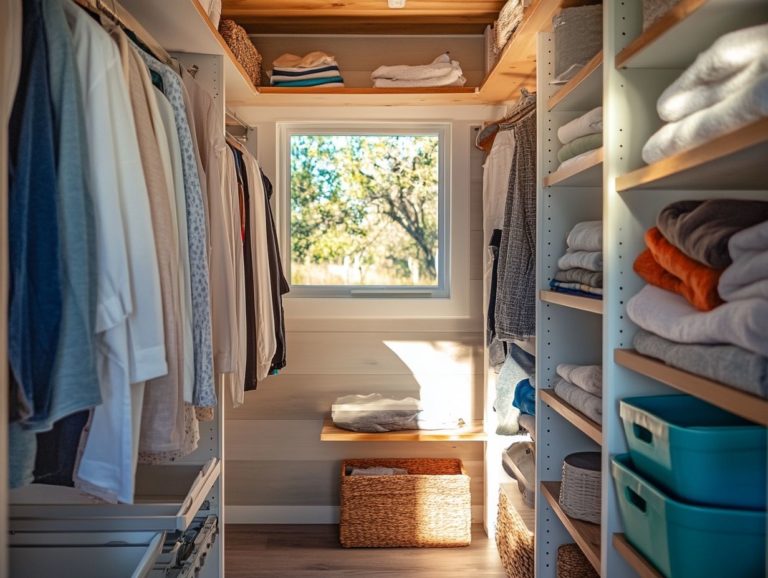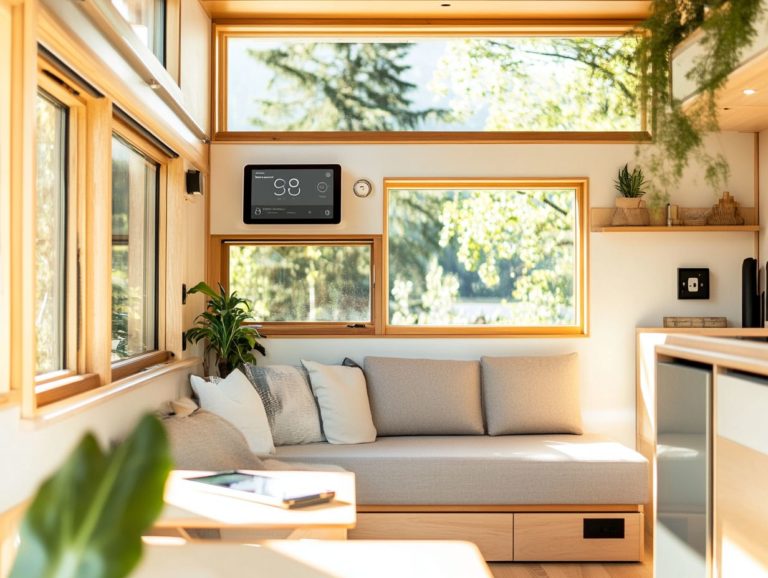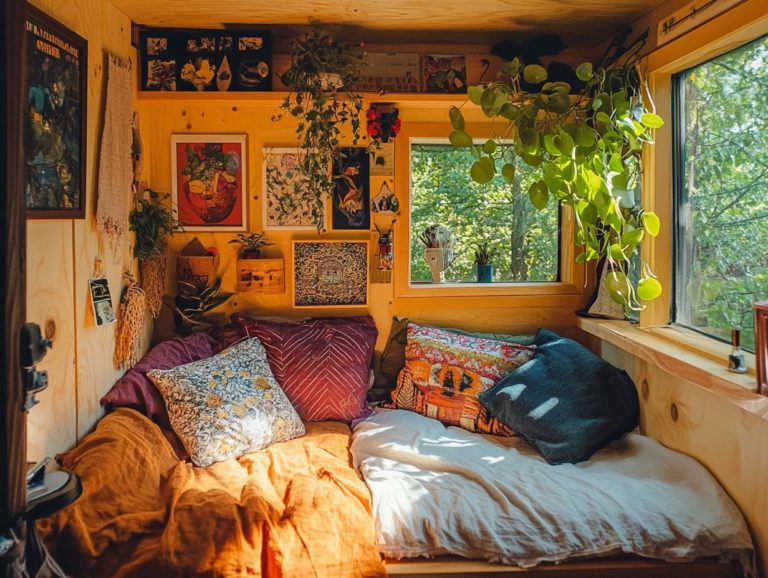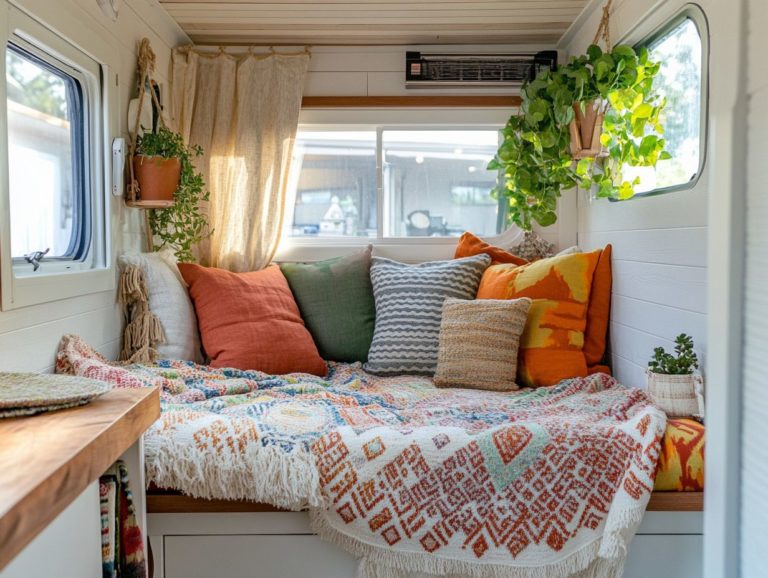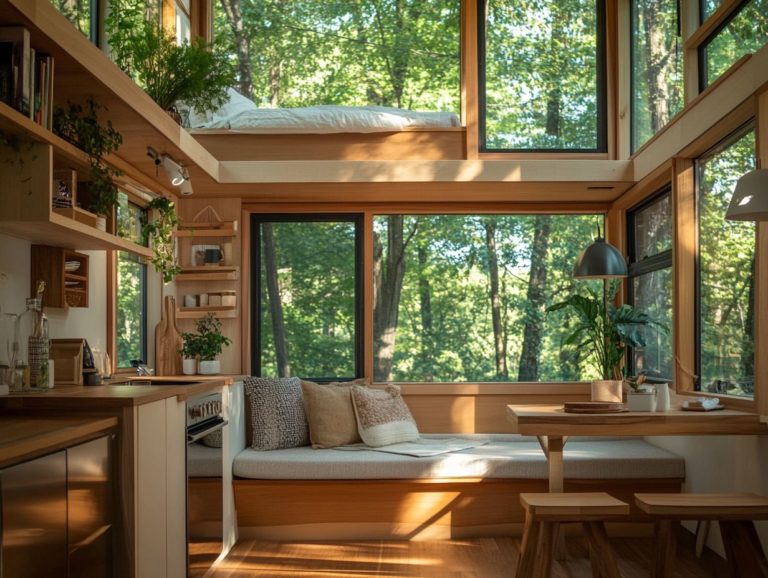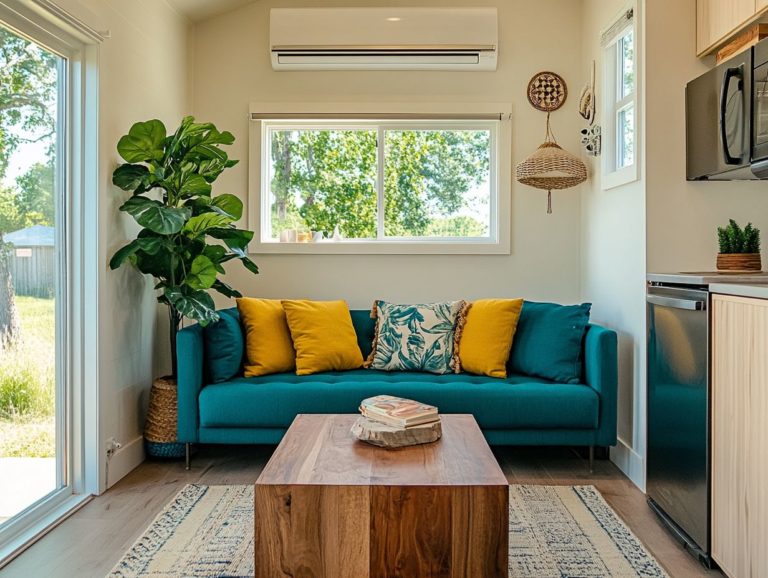5 Tiny House Trends You’ll Love in 2024
As the tiny house movement continues to gain traction in 2024, homeowners and aspiring minimalists are enthusiastically adopting innovative design trends that optimize space while ensuring comfort remains a priority.
With everything from multi-functional furniture to sustainable materials, the latest trends present imaginative solutions for efficient living.
This article delves into the evolution of tiny house trends, highlighting their benefits and challenges, along with practical ways you can integrate these ideas into your own space, including multi-functional spaces.
Discover the exciting future of tiny living and find inspiration for your own journey!
Contents [hide]
- Key Takeaways:
- 1. Multi-Functional Furniture
- 2. Sustainable and Eco-Friendly Materials
- 3. Using Technology
- 4. Creative Use of Space
- 5. Customization and Personalization
- What Is the Concept of Tiny Houses and Why Is It Gaining Popularity?
- Frequently Asked Questions
- 1. What are the top 5 tiny house trends that we can expect to see in 2024?
- 2. How will tiny houses become more environmentally sustainable in 2024?
- 3. Will tiny houses still be considered a budget-friendly housing option in 2024?
- 4. How will tiny houses incorporate smart technology in 2024?
- 5. Will tiny houses become more popular for permanent living in 2024?
- 6. How will tiny houses adapt to changing needs and lifestyles in 2024?
Key Takeaways:
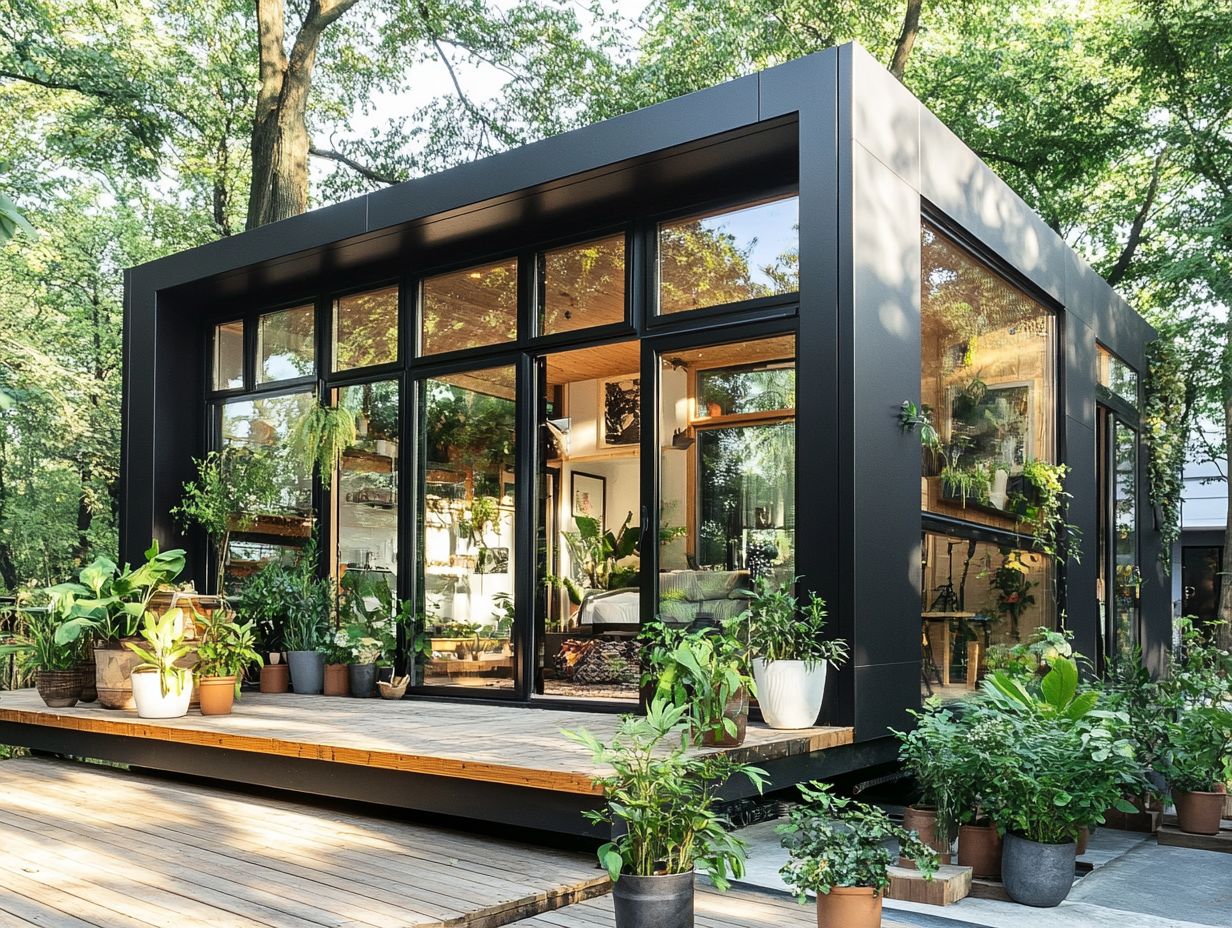
- Multi-functional furniture is a must-have in tiny houses, saving space and providing versatility.
- Sustainable and eco-friendly materials are becoming more popular in tiny house design, promoting a greener lifestyle, including natural wood and artisanal tiles.
- The incorporation of technology in tiny houses is on the rise, making daily life more convenient and efficient.
1. Multi-Functional Furniture
In 2024, multi-functional furniture has become a crucial element of home design. This trend blossomed from the pandemic-induced minimalism that reshaped your perception of space and functionality.
This approach not only highlights the need for optimized storage solutions but also champions sustainable materials.
In contemporary design, especially in the Pacific Northwest, where local artisans like Neil Kelly are setting the standard, furniture that serves multiple purposes is essential. These pieces often incorporate arched doorways and curved lines.
As urban living spaces shrink, incorporating versatile designs like sofa beds and extendable dining tables becomes vital for maximizing your square footage. These pieces transition easily from everyday functionality to elegant features for entertaining guests, showcasing their remarkable adaptability.
Designers are inspired by the push for eco-friendly practices. They use sustainable materials such as reclaimed wood and bamboo, catering to environmentally conscious values. This thoughtful combination enhances the aesthetic appeal of your living space and aligns with a growing commitment to responsible living, resulting in stylish environments that support a healthier planet.
2. Sustainable and Eco-Friendly Materials
Sustainable and eco-friendly materials are becoming essential in your home design, showcasing a heightened awareness of environmental responsibility and the natural beauty that links your indoor spaces with nature.
Designers like Barbara Miller are leading the charge by incorporating natural wood and other sustainable materials, promoting a healthier living environment while elevating the overall aesthetic.
These materials help reduce your carbon footprint and enhance the ambiance of your spaces, creating a serene and inviting atmosphere. Embracing trends like biophilic design, which connects indoor spaces to nature, allows you to cultivate improved mental well-being.
Insights from institutions such as the Eco-Design Institute reveal that integrating nature indoors can boost your productivity and creativity while deepening your appreciation for the environment. This harmonious blend of aesthetics and ethics resonates with those looking to craft living spaces that are not just beautiful, but also sustainable.
3. Using Technology
The use of technology in home design has truly reached new heights. Features like hidden charging stations and smart home technology are now essential elements of modern living spaces.
As Mary Miksch notes in the Global Work-from-Home Research Project, these advancements enhance convenience and contribute to a seamless aesthetic, particularly in areas like the kitchen island.
This transformation invites you to envision spaces where innovation and style coexist beautifully. Think about the rise of integrated systems that connect lighting, heating, and security into a single, cohesive platform.
Consider the impact of voice-activated assistants like Alexa or Google Home. They enable you to control your environment with just a few simple commands. This represents a significant leap forward in how we interact with our homes.
Developers are prioritizing tech-friendly features, choosing materials and layouts that accommodate these innovations without compromising design. These efforts also elevate functionality and reflect a growing consumer preference for homes that cater to modern lifestyles, artfully marrying advanced technology with timeless aesthetics.
4. Creative Use of Space
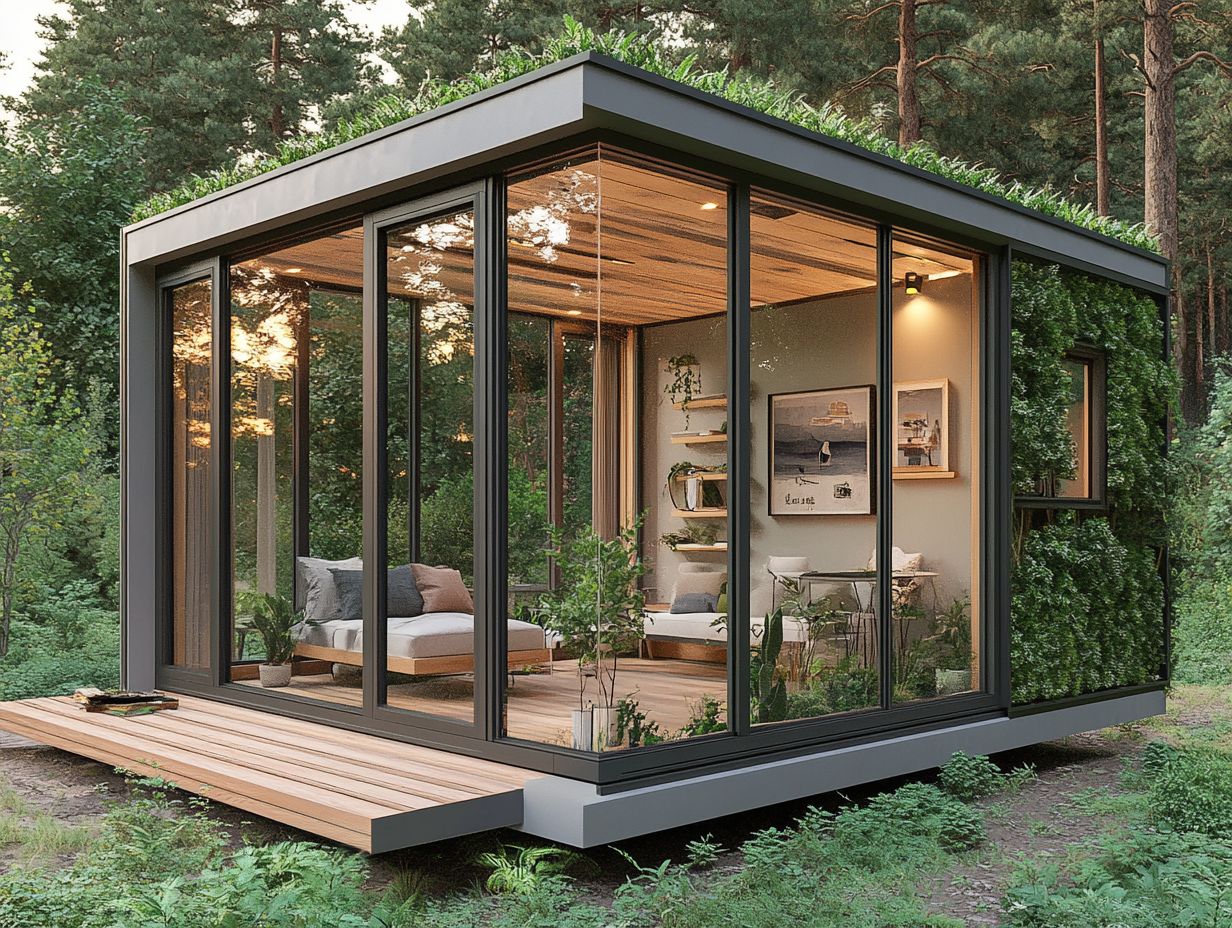
Creative use of space in home design is essential. You ll find that innovative solutions like multi-functional spaces, arched doorways, and statement floors elevate both utility and aesthetics.
Embracing curves and vintage-inspired mirrors adds an elegant touch. This allows you to maximize your living areas beautifully.
This approach underscores the importance of flexibility in your everyday life. It enables you to adapt your environment to suit your varied needs.
Open floor plans are gaining popularity because they offer seamless transitions between areas, fostering a sense of connection and community.
Incorporating custom niches or built-in storage solutions keeps things organized while adding style. With thoughtful furniture placement, you can create inviting corners that double as cozy reading nooks or functional workspaces.
Thoughtful design can truly enhance both comfort and functionality in your modern home.
5. Customization and Personalization
Customization and personalization in home design reflect your desire for unique and individualistic spaces. Trends like Bohemian interior design embrace rich jewel tones, earthy hues, and soft neutrals, letting you create eclectic and inviting atmospheres.
This trend lets you express your identity through curated decor and thoughtful design choices. Color choices are paramount, as each hue conveys a distinct mood. This enables you to craft a particular ambiance in your home.
For instance, vibrant accent walls can infuse energy into your space, while softer palettes may foster a sense of tranquility.
Decor items are equally essential. Incorporating meaningful artwork or unique collectibles allows you to narrate your personal story, making the space genuinely yours.
Your layout preferences whether you lean towards an open concept for lively gatherings or cozy nooks for quiet moments further reflect your lifestyle and values. Currently, the fusion of vintage elements, such as vintage-inspired mirrors, with modern designs has gained traction, resulting in stylish spaces that are also deeply personal.
Don’t miss out on these incredible design trends! Discover how to make the most of your space!
What Is the Concept of Tiny Houses and Why Is It Gaining Popularity?
The concept of tiny houses has surged in popularity due to a desire for simplicity and sustainability. This lifestyle embraces spaces that serve more than one purpose, especially following the pandemic. Advocates like Neil Kelly highlight how these compact homes use sustainable materials and innovative designs to maximize functionality while minimizing environmental impact.
If you’re seeking affordable housing solutions amid rising real estate prices and economic uncertainty, this movement likely resonates with you. Tiny houses promote an eco-conscious way of living by reducing waste and carbon footprints through efficient resource use. For inspiration, check out 5 unique tiny house designs that showcase innovative living options.
You’ll love how this shift allows for personal freedom, enabling homeowners to prioritize experiences over material possessions. With customization options like solar panels and modular furnishings, you can create a space that reflects your unique lifestyle. Consider exploring 5 unique tiny house styles that transform tiny houses into not just sustainable homes, but also personal representations of your values and tastes.
How Have Tiny House Trends Evolved Over the Years?
Over the years, tiny house trends have transformed from basic structures into sophisticated designs that blend various home design styles, including midcentury modern aesthetics and personalized options, as highlighted by experts like Barbara Miller.
This shift mirrors a broader societal movement towards minimalism and sustainability, alongside advancements in building technology and materials. You’ll see diverse design styles, from rustic farmhouse charm to sleek contemporary elegance, incorporating modern tiny house design trends that cater to modern homeowners who want to downsize without sacrificing style or functionality.
The rise of 3D printing and eco-friendly materials has paved the way for innovative layouts and unique touches, ensuring each tiny home reflects individual lifestyles. This focus on customization is appealing for those embracing compact living solutions, showing that choosing less space doesn’t mean sacrificing comfort or individuality. For more insights, explore the future of tiny house design.
What Are the Benefits of Living in a Tiny House?
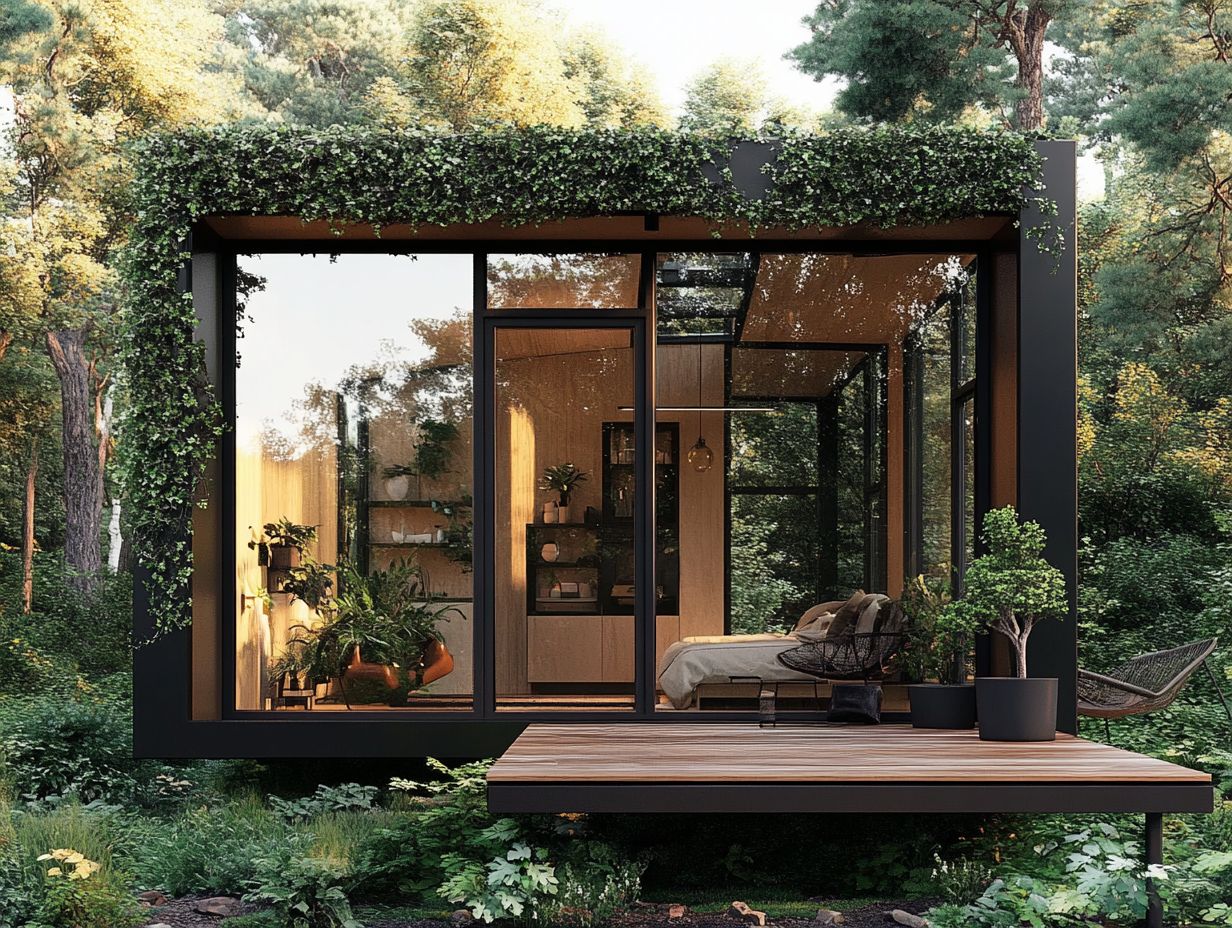
Living in a tiny house offers numerous benefits:
- Financial freedom
- Minimalist lifestyle
- Sustainable living practices through eco-friendly materials
- Lower expenses
- Clutter-free environment
- Greater mobility
The allure of lower expenses pairs beautifully with the joy of a clutter-free environment, where every item serves a purpose. This lifestyle encourages personal savings and reduces your environmental impact, aligning with modern values that prioritize sustainability.
Another significant advantage is greater mobility, allowing you to easily relocate your home and fostering a sense of adventure. Testimonials from tiny house residents reveal transformative experiences; one couple shared how they broke free from the burden of a mortgage, while another emphasized the newfound freedom to travel extensively. If you’re interested in design, exploring the top tiny house design trends can inspire your journey.
These stories embody a shift toward more conscious living that resonates with those who are eco-minded, like you.
Ready to embrace a simpler lifestyle? Start your tiny house journey today!
What Are the Possible Challenges of Living in a Tiny House?
While tiny houses offer numerous advantages, they also bring unique challenges that require exceptional organizational skills and strategic design to ensure both functionality and comfort.
As a tiny house dweller, you may find yourself navigating the intricate puzzle of maximizing your living space. This involves effectively utilizing every nook and cranny for storage, which often leads to innovative solutions like multi-functional furniture and cleverly hidden compartments. If you’re interested in this lifestyle, check out tiny house living: a growing trend for more insights.
For example, investing in a fold-out table can liberate precious square footage while still providing a dining area when needed. Vertical storage solutions, such as wall-mounted shelves, can keep your belongings organized without overwhelming your living space.
By planning an efficient layout and prioritizing essential items, you can transform your tiny home into a cozy, inviting retreat that meets your needs without feeling claustrophobic.
How Can One Incorporate These Trends into Their Own Tiny House?
Incorporating contemporary design trends into your tiny house can elevate both its aesthetic charm and functionality. This allows you to embrace personalization while making use of sustainable materials and multi-functional furniture.
Opt for eco-friendly choices like reclaimed wood or bamboo for your floors and countertops to craft a living space that is both stylish and responsible. To maximize your limited square footage, consider selecting furniture that serves multiple purposes think sofa beds or drop-leaf tables that enhance usability without sacrificing style.
Adding personal touches, such as artwork or textiles that reflect your journey, can transform your tiny house into a sanctuary that resonates with your identity. This way, you blend modern trends seamlessly with your unique flair, creating a space that truly feels like home. For those interested in living small, exploring the future of tiny house living can provide valuable insights.
What Are the Predictions for the Future of Tiny Houses?
Predictions for the future of tiny houses suggest that their popularity will continue to soar, with an emphasis on eco-friendly design and innovative solutions tailored to the challenges of compact living, as noted by industry experts like Neil Kelly and the Eco-Design Institute.
With advancements in eco-friendly technology, you can expect the integration of solar panels, rainwater harvesting systems, and energy-efficient appliances to become the norm. These innovations champion sustainable living and significantly cut down on utility costs for homeowners.
The use of sustainable materials, such as reclaimed wood and recycled metals, is expected to gain momentum, catering to environmentally conscious consumers. As society embraces minimalism and seeks to reduce carbon footprints, the tiny house movement may transform urban landscapes, prompting changes in housing regulations and land use that support these distinctive dwellings. For more insights, explore the emerging trends in tiny house communities.
Frequently Asked Questions

1. What are the top 5 tiny house trends that we can expect to see in 2024?
In 2024, the top 5 tiny house trends predicted to be popular are smaller and more efficient designs, incorporation of smart technology, sustainable living options, multi-functional furniture, and off-grid capabilities.
2. How will tiny houses become more environmentally sustainable in 2024?
In 2024, tiny houses will utilize more eco-friendly materials, such as bamboo and recycled materials, to reduce their carbon footprint. Many tiny houses will also be equipped with solar panels and rainwater harvesting systems for self-sufficiency.
3. Will tiny houses still be considered a budget-friendly housing option in 2024?
Yes, even in 2024, tiny houses will still be a budget-friendly housing option. While prices may increase due to demand, they will remain significantly more affordable than traditional homes, especially with the option for DIY construction.
4. How will tiny houses incorporate smart technology in 2024?
In 2024, tiny houses will utilize smart technology to make living in a small space more convenient and efficient. This could include voice-activated controls, energy-saving devices, and integrated entertainment systems.
Ready to start your tiny house journey? Explore more insights!
5. Will tiny houses become more popular for permanent living in 2024?
Yes! In 2024, more people are expected to choose tiny houses for permanent living. With remote work on the rise and a growing desire for simpler, sustainable lifestyles, tiny homes are becoming the go-to choice for many.
6. How will tiny houses adapt to changing needs and lifestyles in 2024?
Tiny houses will feature designs that adapt to changing needs. Expect flexible layouts that can be expanded or rearranged, along with customization options for families or retirees.

